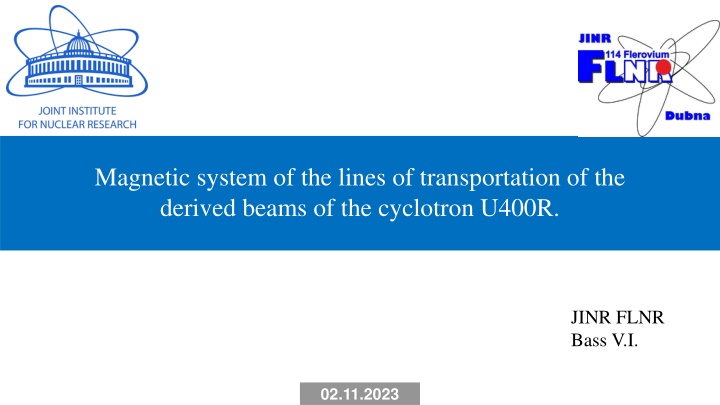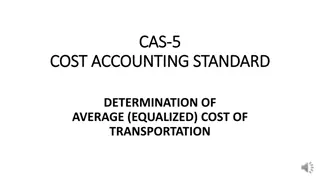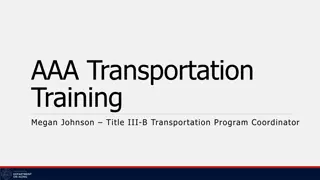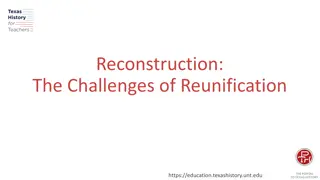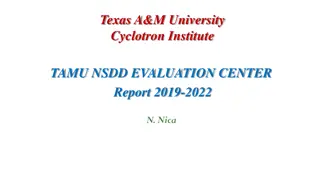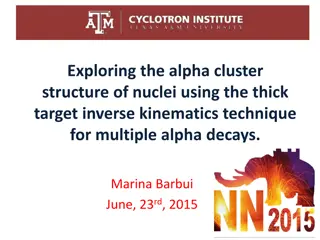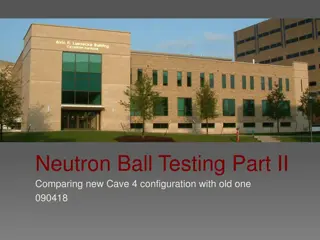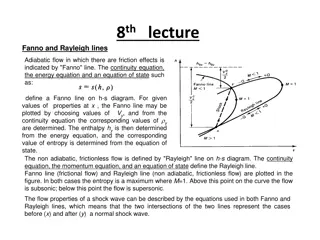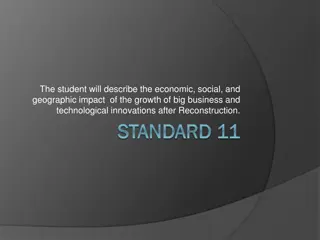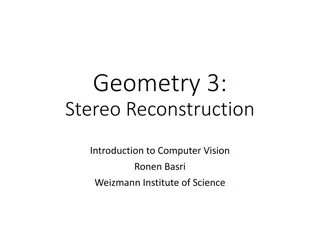Reconstruction of U400 Cyclotron Transportation Lines at JINR FLNR
The Flerov Laboratory of Nuclear Reactions at the Joint Institute for Nuclear Research is reconfiguring the U400 cyclotron to enhance transportation of charged particle beams. The project involves creating new channels to the SHELS installation and New Experimental Hall. Detailed calculations of turning magnets in the magnetic system of transportation lines are presented, highlighting parameters and designs for efficient beam transport.
Download Presentation

Please find below an Image/Link to download the presentation.
The content on the website is provided AS IS for your information and personal use only. It may not be sold, licensed, or shared on other websites without obtaining consent from the author.If you encounter any issues during the download, it is possible that the publisher has removed the file from their server.
You are allowed to download the files provided on this website for personal or commercial use, subject to the condition that they are used lawfully. All files are the property of their respective owners.
The content on the website is provided AS IS for your information and personal use only. It may not be sold, licensed, or shared on other websites without obtaining consent from the author.
E N D
Presentation Transcript
Magnetic system of the lines of transportation of the derived beams of the cyclotron U400R. JINR FLNR Bass V.I. 02.11.2023
Introduction The Flerov Laboratory of Nuclear Reactions of the Joint Institute for Nuclear Research is carrying out work on the reconstruction of the U400 cyclotron in the U400R. The accelerator reconstruction project assumes the creation of new channels for transporting charged particles in two main directions: to the SHELS installation and to the New Experimental Hall (NEH). Within the framework of this article, the results of three- dimensional calculations of TM turning magnets, which are part of the magnetic system of transportation lines of derived charged particle beams, are considered. 2 Joint Institute for Nuclear Research
1. General layout of transportation channels SHELS installation Figure 1. Arrangement of beam transport channels from the U400R cyclotron to the SHELS installation and to the physical installations in the NEH Beam 48Ca+9 Maximum stiffness BR= 3,31 T*m 3 Joint Institute for Nuclear Research
2. The beam line directed to the installation of SHELS 2.1. Turning Magnet TM1 Parameters 1 40,6 Beam rotation angle (grad.) The direction of the median plane Horizontal Magnetic induction , Radius of rotation of the central trajectory R, m 1, 655 2 The inter-pole gap d, mm Pole width l, mm Inhomogenity of radial distribution Magnetomotive force, A turns Winding Conductor 82 250 10^(-4) 166891 Section: 13,4 13,4 mm mm Water channel: =9,1 Figure 2. Arrangement of beam transport channels from the U400R cyclotron to the SHELS installation and to the physical installations in the NEH Half size 48Ca+9 Horizontally ax = 2,11 Vertically ay= 2,65 Angle of the end bevel: input output Number of turns in the winding Rated current, Power supply, kW Cooling water consumption, l/min. 10 10 336 496,7 54,617 26,216 Profiling of the poles: Height 1 mm Width 62 mm Magnet weight, t 8,9 The end bevels of the poles with a double fracture are used 4 Joint Institute for Nuclear Research
3. The beam line leading to the New Experimental Hall (NEH) Figure 3. The channel leading to the New Experimental Hall (side view) 5 Joint Institute for Nuclear Research
3.1. Turning Magnet TM2 Parameters 2 19,35 Beam rotation angle (grad.) The direction of the median plane Horizontal Magnetic induction , 1, 367 Radius of rotation of the central trajectory R, m Inhomogenity of radial distribution The inter-pole gap d, mm Pole width l, mm Magnetomotive force, A turns 2,16 10^(-4) 82 250 101553 Figure 4. Three-dimensional model of the TM 2 turning magnet with a rotation angle of 19.35 and a turning radius R 2.16 m Winding Conductor Section: 13,4 13,4 mm mm Water channel: =9,1 mm Angle of the end bevel: input output Number of turns in the winding 0 0 280 Half size 48Ca+9 Horizontally ax = 3,1 Vertically ay= 0,34 Rated current, Power supply, kW Cooling water consumption, l/min. 362,69 16,514 7,827 Profiling of the poles: Height 1 mm Width 52 mm Magnet weight, t 4,7 6 Joint Institute for Nuclear Research
3.2. Turning Magnets TM3/TM4 Parameters 3/TM4 7,5 Vertical 0,948 2 10^(-4) 82 200 82537 Beam rotation angle (grad.) The direction of the median plane Magnetic induction , Radius of rotation of the central trajectory R,m Inhomogenity of radial distribution The inter-pole gap d, mm Pole width l, mm Magnetomotive force, A turns Winding Conductor Section: 11,5 11,5 mm mm Water channel: =7,5 mm Figure 5. Turning magnets TM 3, TM4 with a rotation angle of 7.5 and a turning radius R 3.1 m Angle of the end bevel: input output Number of turns in the winding Rated current, Power supply, kW Cooling water consumption, l/min. Magnet weight, t 0 0 216 382,12 10,791 1,295 1,75 Half size 48Ca+9 Horizontally ax = 3,37 Vertically ay= 0,61 Profiling of the poles: Height 1 mm Width 50 mm 7 Joint Institute for Nuclear Research
3.3. Turning Magnets TM5 Parameters 5 0 , 40 Beam rotation angle (grad.) The direction of the median plane Horizontal Magnetic induction , 1, 294 2,558 Radius of rotation of the central trajectory R, m The inter-pole gap d, mm 80 Pole width l, mm Magnetomotive force, A turns 310 85800 Winding Conductor Section: 13,4 13,4 mm mm Water channel: =9,1 mm Figure 6. Turning magnet TM5 with rotation angles = 40 , 0 and turning radius R 2,558 m Angle of the end bevel: input output Number of turns in the winding Rated current, Power supply, kW Cooling water consumption, l/min. 0 0 220 390 31,65 15,193 Half size 48Ca+9 Horizontally ax = 4,04 Vertically ay= 1,85 Magnet weight, t 44,2 The end bevels of the poles with a double fracture are used 8 Joint Institute for Nuclear Research
Conclusion alculation of the turning magnets of the system for transporting charged particle beams of the cyclotron U400R has been completed. Charged particle beams are transported in two main directions: to the SHELS installation and to the New Experimental Hall (NEH). Were calculated and designed: Turning magnet TM1, where the particle beam is transported to the NEH with zero rotation, and for transportation to the SHELS installation, the particle beam is rotated by an angle of 40.6 ; a TM 2 magnet that turns a beam of charged particles horizontally by 19.35 in the direction of the NEH.; turning magnets TM3 and TM4, rotating particle beams by 7.5 in the vertical direction.;separating magnet TM5, with rotation angles 40 , 0 and a turning radius of 2.558 m, separating particle beams into three main directions to physical installations. 9 Joint Institute for Nuclear Research
